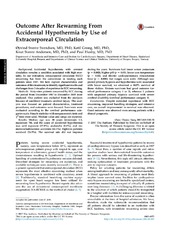| dc.description.abstract | Background: Accidental hypothermia with arrested circulation remains a condition associated with high mortality. In our institution, extracorporeal circulation (ECC) rewarming has been the cornerstone in treating such patients since 1987. We here explore characteristics and outcomes of this treatment, to identify significant merits and challenges from 3 decades of experience in ECC rewarming. Methods: Sixty-nine patients rewarmed by ECC during the period from December 1987 to December 2015 were analyzed. One patient was excluded from the analyses because of combined traumatic cerebral injury. The analysis was focused on patient characteristics, treatment procedures, and outcomes were focused. Survivors were evaluated according to the cerebral performance categories scale. Simple statistics with nonparametric tests and χ2 tests were used. Median value and range are reported. Results: Median age was 30 years (minimum 1.5, maximum 76), and the cause of accidental hypothermia was cold exposure (27.9%), avalanche (5.9%), and immersion/submersion accidents (66.2%). Eighteen patients survived (26.5%). The survival rate did not improve during the years. Survivors had lower serum potassium (p = 0.002), higher pH (p = 0.03), lower core temperature (p = 0.02), and shorter cardiopulmonary resuscitation time (p = 0.001), but ranges were wide. Although suspected primary hypoxia and hypothermia were associated with lower survival, we observed a 10.5% survival of these victims. Sixteen survivors had good outcome (cerebral performance category 1 or 2), whereas 2 patients with suspected primary hypoxia survived with severe cerebral disability (cerebral performance category 3). Conclusions: Despite extended experience with ECC rewarming, improved handling strategies, and intensive care, no overall improvement in survival was observed. Good outcome was observed even among patients with a dismal prognosis. | en_US |

